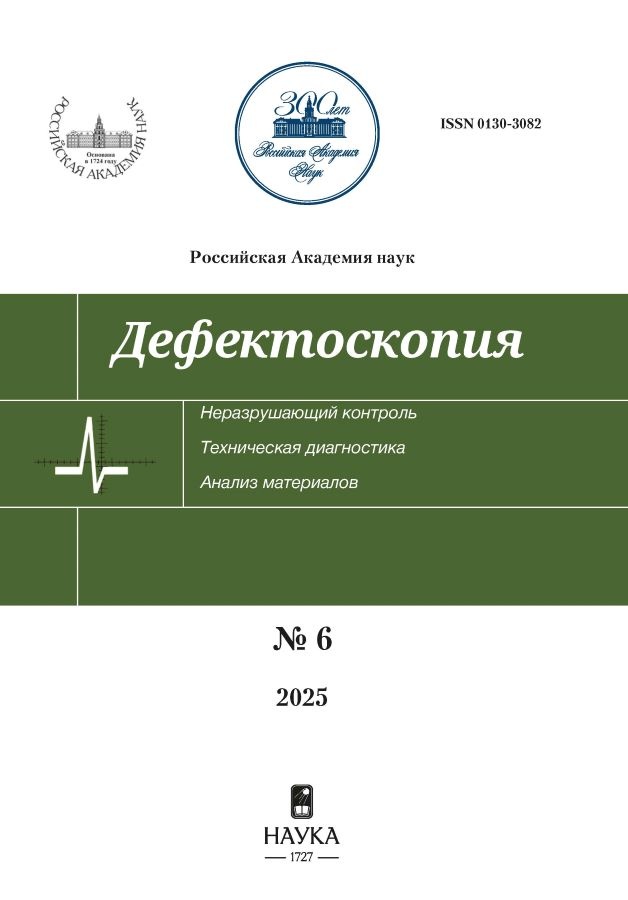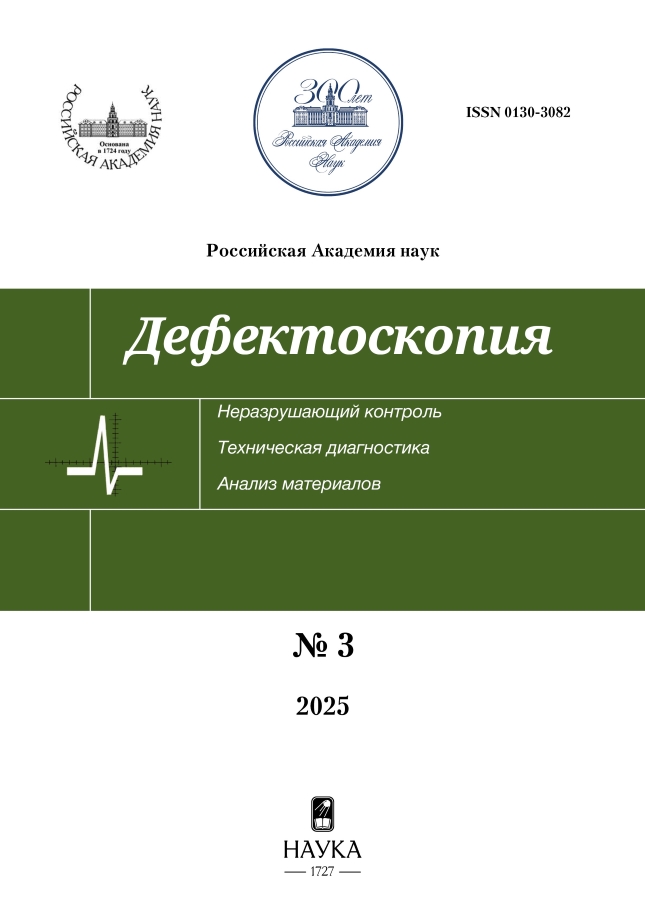No 3 (2025)
Acoustic methods
Ultrasonic Testing of Acoustic and Elastic Properties of 12Cr18Ni10Ti Steel Irradiated with Fast Electrons
Abstract
Special steel grades such as ChS-68 and 12Cr18Ni10Ti are used in nuclear power engineering, the space industry, medicine and other important areas of the technical sphere, and during operation are exposed to various types of destructive effects, including radiation load. This paper presents the results of a study of the effect of high-energy electron radiation on the acoustic properties of austenitic stainless-steel grade 12Х18Н10Т. It was experimentally established that after exposure to electrons with an energy of 10 MeV, such parameters as the attenuation coefficient of ultrasound and the propagation velocity of transverse waves and Rayleigh waves change. These changes are due to defect formation and structural modifications of the material caused by radiation exposure. The obtained data allow us to conclude that it is necessary to take into account changes in the acoustic properties of steels when assessing their performance under radiation exposure.
 3-13
3-13


Asymptotics of an Ultrasonic Sounding Field in Anisotropic Materials
Abstract
To model the wave field of an ultrasonic transducer in materials with strong anisotropy (monocrystalline alloys of turbine blades, composite materials, welded joints, etc.), a physically descriptive asymptotic representation is obtained for quasi-spherical body waves excited by a surface source in an arbitrarily anisotropic elastic half-space. The asymptotics is derived by the stationary phase method from the integral representation of the solution in terms of contour integrals of the inverse Fourier transform. The peculiarities of their derivation and numerical implementation are discussed on the examples of a transversely isotropic composite material and a monocrystalline nickel alloy with cubic anisotropy. The dependence of the stationary points on the direction is more complicated here than in the isotropic case, up to the appearance of multiple stationary points and folds, giving rise to additional wave fronts and caustics. A comparison is made with the plane waves described by eigensolutions of the classical Christoffel equation. It is shown that, despite the phenomenon of multiple wave fronts, varying the plane-wave orientation allows us to obtain the same group velocity vectors as for any of the waves described by the asymptotics.
 14-28
14-28


Analysis of the Requirements for Metrological Support of Methods and Means of Ultrasound Control
Abstract
Establishing requirements for acoustic measurements and standard samples and monitoring their implementation during production and certification is an important task. In this paper, the parameters affecting the propagation velocity of elastic waves in steel are considered, and their contribution to the total uncertainty of measuring the propagation velocity of a longitudinal wave is determined. Based on the data obtained, an analysis of the standards devoted to ultrasonic testing methods was carried out in terms of the requirements for standard samples. The conducted research allowed us to establish that the requirements imposed by the current standards do not sufficiently take into account a number of factors that may affect the characteristics of ultrasound measures and reference samples. Standard samples made without taking these factors into account are unlikely to adequately assess the metrological characteristics of ultrasound equipment.
 29-46
29-46


Radiation methods
Development of Methods for Shell and Fuel Layer Characterization of Indirect-Drive Cryogenic Target for Laser Thermonuclear Fusion
Abstract
Indirect-drive cryogenic target is a located in box-converter hollow spherical shell-capsule with spherically symmetric solid layer of deuterium-tritium fuel on its inner surface. Placing a cryogenic target in an experiment on ignition at a megajoule energy level facility is preceded by thorough characterization of all component elements of the target and characterization of finished target. This paper describes the characterization method of the entire external surface of the cryogenic target using a confocal scanning, and presents the results of developing an optical shadow method and an X-ray phase-contrast method for characterization the cryogenic fuel layer in the target. The results of stitching the entire external surface are used for interpretation of the results of experiments on the solid fuel layer formation in a cryogenic target. The developed program system for characterization of fuel layers is used for measuring the liquid fuel, for characterization of the solid fuel layer parameters and for evaluation the robustness of the characterization results.
 47-58
47-58


Other methods of flaw detection
Real-Time Control of Direct Laser Deposition Process of Inconel 718 Using Laser Emission Spectroscopy
Abstract
Using atomic emission spectroscopy, the gas-plasma plume generated during laser selective melting of various alloys was investigated. It was demonstrated that the type of protective gas used affects the spectral characteristics. The use of helium as a process gas compared to argon reduces overall luminescence and the contributions of individual elements to the spectrum, indicating lower losses of these elements through evaporation under laser radiation exposure.
 59-67
59-67


Thermal methods
Terahertz Detection and Evaluation of Thermal Barrier Coating Thickness
Abstract
Thermal barrier coatings are mainly used for thermal protection of turbine blades, and accurate non-destructive measurement of their thickness is a key factor in evaluating the integrity of blade quality. This article uses a reflective terahertz time-domain spectroscopy system to measure the thickness of thermal barrier coating samples, obtaining the refractive index of several thermal barrier ceramic coating material samples under different preparation conditions in the terahertz frequency band. Then, the reflective terahertz measurement system is used to obtain the time-domain signals of thermal barrier ceramic coating samples under different preparation conditions, extract different time-domain features, calculate the coating thickness, and compare them. The phenomenon of waveform broadening caused by dispersion during the transmission of terahertz waves in different samples was studied, and the impact of waveform broadening on the measurement of thermal barrier coating thickness was qualitatively analyzed. Compared with the results of metallographic thickness measurement, the deviation of the results is within the error range, and the comparison results show good consistency. It also provides useful reference for using terahertz technology to detect the thickness of thermal barrier coatings on turbine blades and evaluate structural quality.
 68-78
68-78












